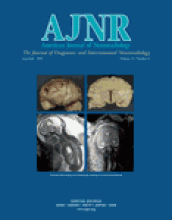Abstract
BACKGROUND AND PURPOSE: Diffusion-weighted (DW) imaging is more sensitive for early ischemia than CT, and apparent diffusion coefficient (ADC) mapping permits quantification of the severity of cytotoxic edema. We examined the relationship between early CT findings, ischemic lesion volume on DW images, and edema subtype.
METHODS: Patients in whom early signs of ischemia were detected on baseline CT scans were scored CT positive. Baseline DW lesion volumes were compared between the CT-positive and CT-negative patients. In CT-positive patients, we outlined the CT-positive part of the DW lesion and transferred these regions of interest to the corresponding DW sections. The ADC values of the outlined CT-positive areas were then compared with the ADC values of the CT-negative areas within patients. Lesions with significantly increased T2 hyperintensity were excluded to correct for the effect of early vasogenic edema on ADC measurements.
RESULTS: Twenty-four patients with cerebral ischemia in whom both CT and DW imaging were performed within 8 hours of symptom onset were entered into the study. Patients with early CT signs of infarction (n = 12) had significantly larger DW lesion volumes than did patients without early CT abnormalities (mean volume, 62.8 versus 14.6 mL; P = . 002). In patients displaying early CT abnormalities, CT-positive regions of the DW lesion had lower relative ADC (rADC) values than did the CT-negative regions, when lesions with significant T2 hyperintensity were excluded (mean rADC, 0.65 versus 0.75; P = .037).
CONCLUSION: These findings support the hypothesis that early CT signs of infarction indicate more extensive and severe cerebral ischemia, as reflected by lower ADC.
- Copyright © American Society of Neuroradiology












